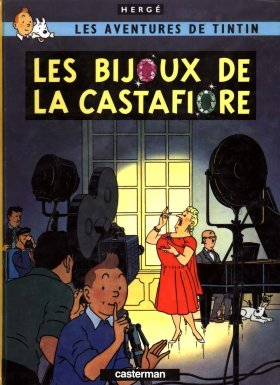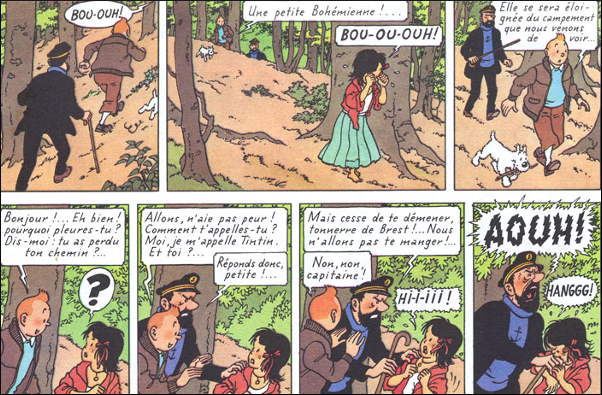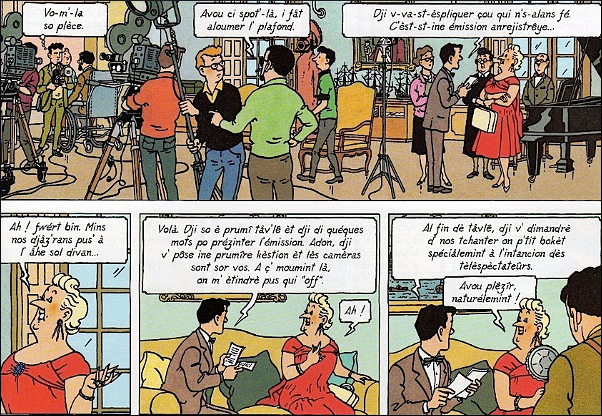
- The Castafiore Emerald
- Published by: French and European Publishing
- Level: Beginner
- First Published in: 1963
One of the most famous installments in Hergé's long-running Tintin series of comic books.

Hergé, a Belgian cartoonist, wrote this graphic novel in 1963. We encounter the two main protagonists, Tintin and Captain Haddock, taking a stroll in the woods. Captain Haddock makes a remark about the natural loveliness surrounding them, mentioning the “gazouillis des ouiseaux” (chirping of the birds) and the “bonne odeur d’humus” (lovely musk of the earth). Tintin, on the other hand, notices that it stinks and that they are actually passing next to a landfill.
"In Europe, the Romani had a bad reputation for supposedly stealing and being dirty, which is reflected in the reactions of the characters."
Then, they encounter the “Romanichels,” the local gypsies, also referred to as “caravane de Bohémiens” and “les nomads.” In Europe, they had a bad reputation for supposedly stealing and being dirty, which is reflected in the reactions of the characters. Captain Haddock first exclaims, “Aucun sens de l’hygiène ces zouaves-la!” (No understanding of hygiene, those wild ones). The term “zouaves” derives from the name given to military recruits from Algeria by the French. Although he insults them at first, Captain Haddock comes to understand that they did not have much of a choice in locating their encampment next to the landfill. He shows a kind heart by letting them into his large estate so they can get away from the garbage. However, Tintin spies on them throughout the book, and Haddock’s butler shows snobbish resistance at letting them stay on his grounds. Some of the gypsies, in turn, call everyone else a “gadjo,” a derogatory word for “outsider.”

Some of Captain Haddock’s expressions are very typical and even famous. When an Italian opera singer, named Bianca Castafiore, invites herself to Haddock’s home, he is annoyed and says, “tonnerre de Brest” (thunder in Brest), presumably referencing his experiences out in the ocean. His most famous line is, “Mille milliards de mille sabords,” recalling his time as a seafarer, allowing boats to sink, many millions of them, which is of course a horrible thing for a sea captain. Mrs. Castafiore offers Haddock a parrot, and Haddock attempts to bond with it, making “kili kili kili” noises (a playful onomatopoeia for “tickling” in French). But the parrot bites Haddock, and he shouts, “Mille milliards de mille sabords.” Milou, Tintin’s dog, comments ironically, saying, “Je ne supporte pas ces bêtes qui parlent” (I can’t stand animals that talk).
Throughout most of the story, Haddock is injured and chair-ridden after a fall, making Castafiore’s stay even harder to endure. Luckily, Tintin finds him a wheelchair, calling it a “voiture de course” (a racecar). In the meantime, Paris Flash, a popular French tabloid, interviews Castafiore and interprets her visit as a prelude to her marriage to Haddock. The local professor exclaims at the news, “Saperlipopette,” a very outdated way of expressing surprise. Journalists, on the other hand, use trendy 1960s slang, shortening words: “D’accord!” becomes “D’ac!” and “Un papier sensationelle” becomes “Un papier sensass.” Meanwhile, Castafiore regularly screams about her jewelry being stolen, but simply keeps misplacing it. Many of the main characters suspect the gypsies are to blame, but it turns out the culprit is a “pie” (or magpie), which hoarded the jewelry in its nest the whole time.

